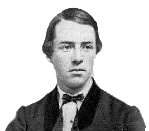April 28. — The general received a telegram from Captain Lubey, saying that the pontoon train arrived at Warrenton at 7.30 o’clock this morning. I took the telegram, or rather a verbal message, to General Butterfield, to the effect that the train arrived at Warrenton at 7.30. General Benham then went over to General Sedgwick’s, with Perkins and myself. General S., General Sickles, and General Reynolds were there. After leaving there, General B. sent me with a message to Major Cassin, saying that he wished his train to be moved over the crest near the Wallace House. Major Cassin moved his train as ordered, and proceeded down to the pine forest near the river bank. At five o’clock in the afternoon, General Sedgwick and General Newton came to headquarters, and General B. went with them to the river, where they left me. I went back to headquarters in accordance with General B.’s orders, having waited for him an hour. At nine in the evening, General Hunt arrived here, and with all his staff, General Benham started for General Sedgwick’s headquarters. After remaining here for half an hour, or rather 15 minutes, General Benham went on towards the river, until he met General Pratt. He ordered me to stay with General Pratt, and as soon as the enemy took the alarm to order the batteries down, and one train of pontoon equipage. While here, General Benham had a row with General Sedgwick’s aide, Captain Halstead.
General Benham, after giving his instructions to General Pratt and other officers, left for the lower bridges. General Pratt sent me down to the river to give notice as soon as the enemy were alarmed, General Newton’s officers, who were to perform that duty, not being present. I waited on the bank of the river some half hour, having first questioned all the pickets in regard to any sounds or noises heard on the opposite bank. Everything was very quiet, except the sound arising from our pontoon boats being transported by our men. When the boats arrived at the bank, I joined General Benham. He sent me down to the river’s edge to listen, and to see whether the enemy were aware of our approach. I soon heard the clanking of swords, etc., and saw signals displayed, and so informed the general. By one or two o’clock some 40 boats were at the river’s bank. At four our men crossed, one volley and a few scattering shots being all the resistance that they encountered. Some half a dozen men were wounded. The time between 4 and 6 o’clock was occupied in crossing troops.[1]
[1] Gen. Hooker’s movement to turn the Confederate left flank, which resulted in the battle of Chancellorsville, began on April 27, when a force under Sedgwick was sent across the Rappahannock below Fredericksburg.



